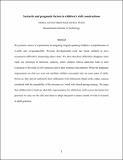Syntactic and Pragmatic Factors in Children’s Comprehension of Cleft Constructions
Author(s)
Aravind, Athulya; Hackl, Martin; Wexler, Kenneth N
DownloadAravind-et-al-clefts.pdf (3.029Mb)
OPEN_ACCESS_POLICY
Open Access Policy
Creative Commons Attribution-Noncommercial-Share Alike
Alternative title
Syntactic and Pragmatic Factors in Children’s Comprehension of Cleft Constructions
Terms of use
Metadata
Show full item recordAbstract
We present a series of experiments investigating English-speaking children’s comprehension of it-clefts and wh-pseudoclefts. Previous developmental work has found children to have asymmetric difficulties interpreting object clefts. We show that these difficulties disappear when clefts are presented in felicitous contexts, where children behave adultlike both in their evaluation of the truth of cleft sentences and in their response-time patterns. When the pragmatic requirements on cleft use were not satisfied, children succeeded only on some types of clefts. However, they did not uniformly show difficulties with infelicitous object clefts; rather, success correlated with the amenability of the structure to a word-order-based parsing strategy. We argue that children fail to build an adultlike representation for infelicitous clefts across the board, but pressures to carry out the task lead them to adopt interpretive means outside of what is licensed in adult grammar.
Date issued
2017-05Department
Massachusetts Institute of Technology. Department of Brain and Cognitive Sciences; Massachusetts Institute of Technology. Department of Linguistics and PhilosophyJournal
Language Acquisition
Publisher
Informa UK Limited
Citation
Aravind, Athulya, Martin Hackl, and Ken Wexler. “Syntactic and Pragmatic Factors in Children’s Comprehension of Cleft Constructions.” Language Acquisition, May 2017, pp. 1–31.
Version: Author's final manuscript
ISSN
1048-9223
1532-7817